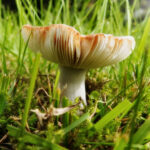How Do Plants Harness Nitrogen-Fixing Bacteria?
Nitrogen-fixing bacteria help plants obtain a usable form of nitrogen. But what’s the science behind it, and how can it benefit crops?
By Rachel Calder
Just as you need to eat a balanced diet with all the right vitamins and minerals in order to stay healthy, plants too can’t live without essential nutrients. One of the most important of these is nitrogen. Given that nitrogen makes up 78 percent of the air we breathe, you might think it would be no problem for plants to get what they need. Unfortunately, it’s not that simple: plants can’t access nitrogen in its gaseous form. Instead, they take up nitrogen compounds like ammonium (NH4+) and nitrate (NO3–) from the soil. These accessible forms of nitrogen are often in short supply, limiting plant growth.
Making nitrogen available
Where do these nitrogen compounds come from? Lightning strikes can cause nitrogen to combine with other elements, ultimately adding plant-usable nitrogen to the soil. Humans, too, can create these compounds. The Haber-Bosch process is used industrially to make nitrogen fertilizers; this consumes lots of fossil fuel energy and the resulting fertilizer is often used in damaging ways. But some plants have found their own solution. They have teamed up with soil-dwelling bacteria that are able to fix nitrogen from the atmosphere into forms that plants can use. Similar nitrogen-fixing bacteria also live independently, adding nitrogen compounds to the soil rather than transferring them to a particular plant host. By allowing nitrogen-fixing bacteria to live in their roots and feeding them, however, certain plants get first dibs on the nitrogen compounds produced by the bacteria. They don’t have to compete with other plants and animals for them.
What’s going on under the soil? Learn more about The Millions of Microbes Beneath our Feet
This partnership between plants and bacteria is a classic example of symbiosis. From the Greek for “living together,” symbiosis means a close and sustained interaction between organisms of different species. In this case, the symbiosis is mutualistic, which means that both partners—the plant and the bacterium—benefit. The plant gets nitrogen, and the bacterium gets food from the plant (made by photosynthesis). Other examples of symbioses can be parasitic, where one partner benefits but the other is harmed; or commensalistic, where one partner benefits while the other is unaffected.
Nitrogen-fixing bacteria can help us farm sustainably
Not all plants have learned this trick. Many of those that have are in the Fabaceae family, otherwise known as legumes. This family of plants includes peas, beans, clover, alfalfa, and even peanuts (which are not technically a nut at all). Farmers have known for centuries that by including these species in their crop rotations, they can improve the fertility of their soils. Sometimes they would grow a whole field of something like alfalfa, not to harvest it for animals to eat, but to plough it back into the soil. That way, all the nitrogen the plant had incorporated from its bacterial helpers as it grew would be put into the soil for other plants to use. As concern grows about our food system’s dependence on vast quantities of industrially produced, polluting nitrogen fertilizer, there is increasing interest in these nitrogen-fixing crops. They could be an important tool for sustainable agriculture.
Are most agricultural practices sustainable? Read how Agricultural Emissions Could Upset Climate Goals
How do plants accommodate nitrogen-fixing bacteria?
If we are going to harness nitrogen-fixing crops in this way, we need a deep understanding of how the symbiosis works. Some aspects of this remain murky, but a team of researchers in Denmark have shone a light on the formation of the symbiosis. They already knew that a crucial protein by the not-so-snappy name of symbiosis receptor-like kinase (we’ll just call it “SYMRK” from now on) was involved. SYMRK picks up signals from the nitrogen-fixing bacteria and in response triggers the formation of root nodules. Root nodules are little lumps on the roots of nitrogen-fixing plants—they’re visible to the naked eye, so if you dig up a bean plant, you might find some. You can think of root nodules as homes for the helpful bacteria—inside the nodules is where nitrogen fixation takes place.
Read more about using nitrogen fixation in agriculture with Hidden Helpers: Bacteria in Leaves
Structure and function are often closely related in biology: things have to be precisely the right shape in order to do their job correctly. SYMRK is no exception to this rule, and the researchers therefore used crystallographic techniques to determine its structure. Crystallography involves firing X-rays at a crystallized substance and using the pattern of X-rays bouncing off the substance to determine its structure at a very small scale. This is no mean feat when you consider how tiny these substances are—bear in mind that SYMRK is much tinier than a plant cell! Once they knew the structure, these scientists compared it to other proteins with known function for an insight into how it might work.
Next, it was time for some experiments to identify which parts of SYMRK seemed to be most important in its functioning. Having drawn up a list of candidates, the scientists tested each site in turn to see which were essential to the symbiosis. They created a series of mutant forms of SYMRK, each with a mutation in a different one of the candidate sites. If a plant with a mutation at a given site in SYMRK could still form root nodules, then that site could not be crucial. On the other hand, if a mutation at a given site resulted in no root nodules, then that could be considered a crucial site for the mechanism of nodule-formation.
Beyond beans
All of this might seem a long way from the farmer’s field. But ambitious attempts are underway to enable non-leguminous crop plants to reap the benefits of association with nitrogen-fixing bacteria and thus reduce the demand for artificial fertilizers. Cereals are a particular target of these efforts, as they are grown in vast quantities but do not naturally fix nitrogen (via symbiotic bacteria) to any meaningful degree. Discoveries about the mechanisms of nitrogen-fixing symbiosis in legumes take us one step closer to this aim of nitrogen-fixing cereals.
This study was published in the journal Proceedings of the National Academy of Sciences (PNAS).
References
Abel, N. B., Nørgaard, M. M., Hansen, S. B., Gysel, K., Díez, I. A., Jensen, O. N., Stougaard, J., & Andersen, K. R. (2024). Phosphorylation of the alpha-I motif in SYMRK drives root nodule organogenesis. Proceedings of the National Academy of Sciences, 121(8), e2311522121. https://doi.org/10.1073/pnas.2311522121
Bernhard, A. (2010). The nitrogen cycle: processes, players, and human impact. Nature Education Knowledge, 3(10), 25.
Rosenblueth, M., Ormeño-Orrillo, E., López-López, A., Rogel, M. A., Reyes-Hernández, B. J., Martínez-Romero, J. C., Reddy, P. M., & Martínez-Romero, E. (2018). Nitrogen fixation in cereals. Frontiers in Microbiology,9, 1794. https://doi.org/10.3389/fmicb.2018.01794
Featured image “Baled Alfalfa” by odonata98 (Kimberly Reinhart) on Flickr; licensed under CC BY-ND 2.0 DEED with no changes made.


About the Author
Rachel Calder’s PhD project focuses on mycorrhizal fungi and soil nutrient cycling, but she is also an inveterate dabbler with a wide enthusiasm for all things Science. Having started out studying history herself, she’s also a big advocate for transcending the arts/sciences divide. Follow her on LinkedIn: www.linkedin.com/in/rachel-m-calder




